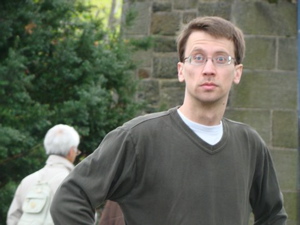The Metaphysics of Mormon Sacrament Meetings, by Matt Bowman
 The heart of the Great Tait-Riess Worship Smackdown of 2010 seems to me a dispute about how precisely we should understand worship and what worship is supposed to accomplish. Beyond any sort of commentary on the content of the discussion, I’m pleased that it’s taking place at all. It’s the sort of discussion that Mormons infrequently have; we spend a great deal of time saying we should do things and very little – beyond generalities about pleasing God or cultivating character – about exactly why.
The heart of the Great Tait-Riess Worship Smackdown of 2010 seems to me a dispute about how precisely we should understand worship and what worship is supposed to accomplish. Beyond any sort of commentary on the content of the discussion, I’m pleased that it’s taking place at all. It’s the sort of discussion that Mormons infrequently have; we spend a great deal of time saying we should do things and very little – beyond generalities about pleasing God or cultivating character – about exactly why.
A couple things worth acknowledging up front, also. One is that a lot of people seem to find the contemporary Mormon sacrament meetings fulfilling and meaningful. Though short of a poll of some kind generalizations about why are probably speculation, there’s some sort of religious satisfaction to be derived from the way Mormons worship now. Another is that despite this in a hundred and eighty years of public preaching, nobody’s ever really had much good to say about the quality of the oratory of the Mormon pulpit; Davis Bitton famously cited a non-Mormon observer baffled by the “strange ramblings” in Brigham Young’s Tabernacle; as one who has admitted boredom in sacrament meeting, then, Jana stands in a noble genealogy that includes Mark Twain.
A useful way to think about Christian worship in general is as a microcosm of what a particular form of Christianity imagines the history of salvation to be. For Jana salvation is the story of an active God, present and manifest in human history; she thus hopes for worship which emphasizes and celebrates the presence of the divine – in spiritual manifestation, singing understood in terms of praise, and, as she says, focus upon God, rather than the spiritual development of the congregants. This is in line with a lot of other Christians; it’s the heart of the Catholic Mass, for instance, which is a dramatic recapitulation of Christ’s death for the benefit of the awestruck audience. Unfortunately for Jana’s sake, there has been very little history of this in Mormon worship; though in the early twentieth century Bach crept into the sacrament meetings, he was firmly driven out by J. Reuben Clark shortly thereafter.
Lisa, on the other hand, emphasizes that this sort of praise and awe is something to be tasted on an individual rather than corporate level. Communal worship is to be active rather than passive. This is interesting, because she describes (but does not invoke by name) a concept central to modern Mormon worship which would seem to be in line with a great deal of what Jana says: reverence. What’s key, however, is how the term is used; reverence is not, in Lisa’s description, associated with majesty or prostration at the feet of the throne of God, but rather, with self-discipline and the ability to sit still. For Lisa, salvation is the story of the community and devotion to it, and those boring sermons delivered by our friends and fellow Saints are to be praised not for their content or style but simply because they are given and we gather together to listen. This style of worship also has a Christian heritage in the Reformed churches and particularly among the Puritans, for whom the chapel was a schoolhouse for the saved rather than the Catholic stage where the drama of salvation was enacted for sinners.
So which of these versions is more Mormon? The fascinating thing is, theoretically at least, I think that’s an open question. As I’ve said, Mormons spend most of their time doing a lot of things; we are a pragmatic, functionalist, and purpose driven people. There’s a lot to be said for this; for instance, it makes Mormon community incredibly robust. And I suspect that it’s precisely that streak which inspired many of the hostile comments on Jana’s original post. We make this liturgy because we want to worship God. Full stop. And even if the sermons are boring they march us toward that end.
It’s because of these reasons that I actually find what Jana and Lisa are doing to converge in method and metaphysic, if not in argument. In both their essays, worship is not merely ends driven, a tool for making us better; rather, worship offers new vistas of imagination, a glimpse at who we are and how we are positioned in the universe as God imagines it, and which diverge from the structures that the economic, cultural, and political worlds that we ourselves create. This is not merely intellectual; it’s aesthetic, and at a gut level, even wrenching and transformative. So it matters less to me, I think, precisely how we worship than how we talk about it does.
Matthew Bowman is a graduate student in the department of history at Georgetown University, and a 20010-2011 Charlotte W. Newcombe Dissertation Fellow. His dissertation is on evangelical practices in New York City during the rise of fundamentalism. He lives in Washington DC, where he divides his time among evangelicals, Mormon history, books by Raymond Chandler, and figuring out ways to follow the Utah Jazz.

